Audit and Assurance Report: IESBA, Ethical Threats, and Safeguards
VerifiedAdded on 2021/04/19
|9
|2534
|411
Report
AI Summary
This report provides a detailed analysis of audit and assurance principles, focusing on the role of the International Ethics Standards Board for Accountants (IESBA). It begins with an introduction to auditing and the importance of ethical principles, highlighting IESBA's function in setting ethical standards for accountants and auditors worldwide. The report then explores IESBA's specific roles, including developing high-quality ethical standards, issuing revised codes of ethics, and promoting convergence of international and national ethical standards. The report further examines five hypothetical situations, each presenting different threats to audit independence, such as self-interest and familiarity threats. For each situation, the report identifies the threat, its consequences, and potential safeguards to mitigate the risk and ensure unbiased audit opinions. The report concludes by emphasizing the critical role of ethical principles in maintaining the integrity and effectiveness of audit operations.
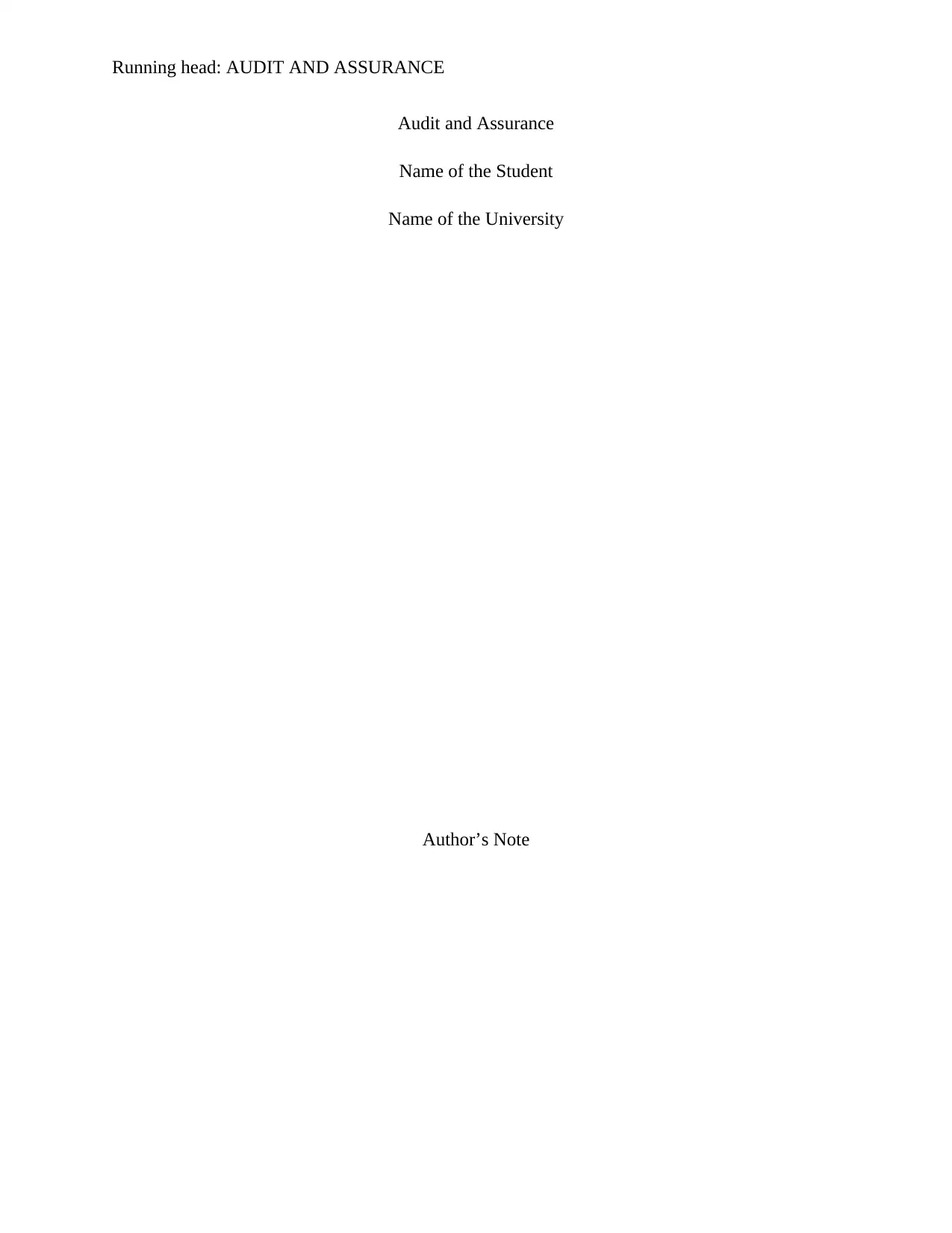
Running head: AUDIT AND ASSURANCE
Audit and Assurance
Name of the Student
Name of the University
Author’s Note
Audit and Assurance
Name of the Student
Name of the University
Author’s Note
Paraphrase This Document
Need a fresh take? Get an instant paraphrase of this document with our AI Paraphraser
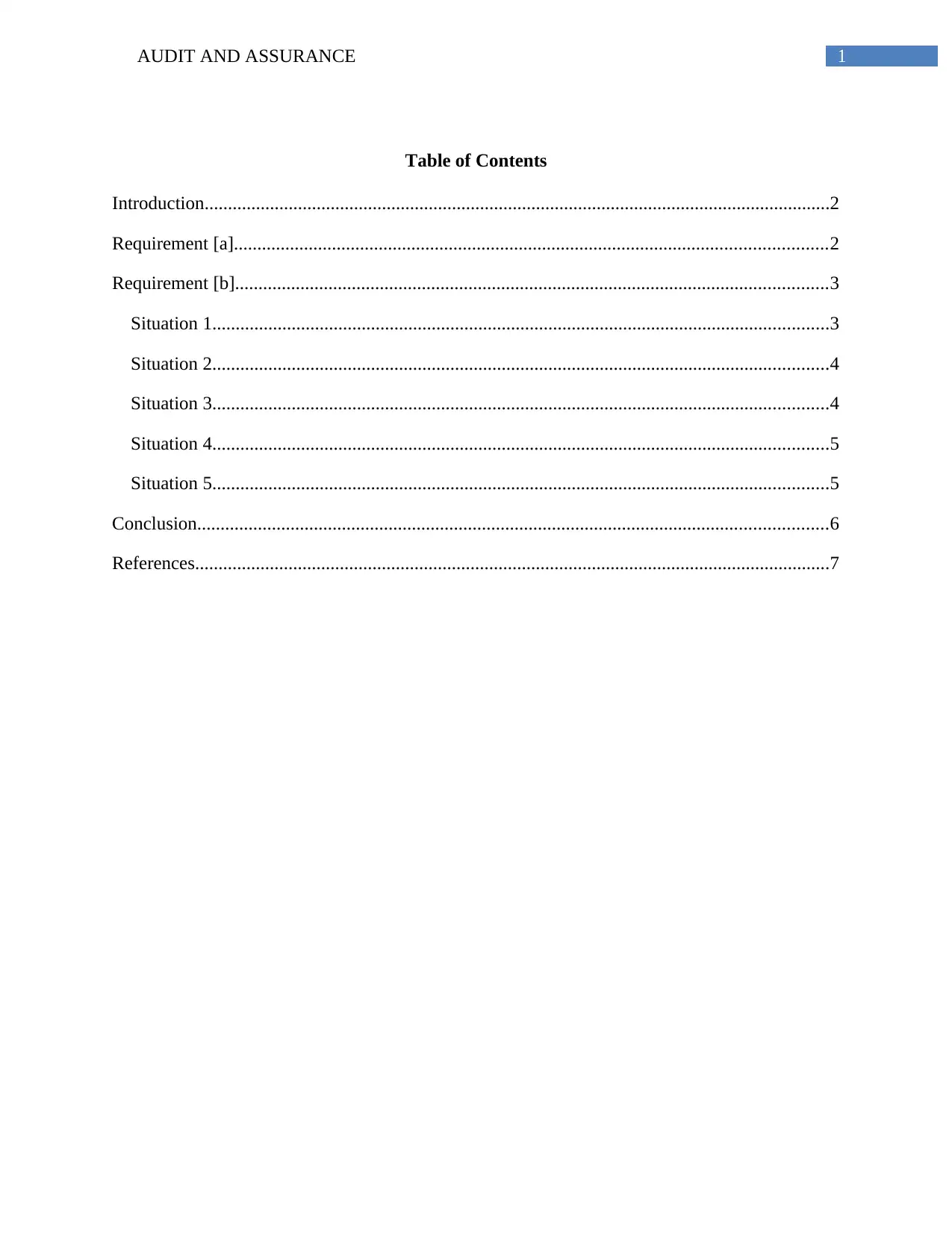
1AUDIT AND ASSURANCE
Table of Contents
Introduction......................................................................................................................................2
Requirement [a]...............................................................................................................................2
Requirement [b]...............................................................................................................................3
Situation 1....................................................................................................................................3
Situation 2....................................................................................................................................4
Situation 3....................................................................................................................................4
Situation 4....................................................................................................................................5
Situation 5....................................................................................................................................5
Conclusion.......................................................................................................................................6
References........................................................................................................................................7
Table of Contents
Introduction......................................................................................................................................2
Requirement [a]...............................................................................................................................2
Requirement [b]...............................................................................................................................3
Situation 1....................................................................................................................................3
Situation 2....................................................................................................................................4
Situation 3....................................................................................................................................4
Situation 4....................................................................................................................................5
Situation 5....................................................................................................................................5
Conclusion.......................................................................................................................................6
References........................................................................................................................................7
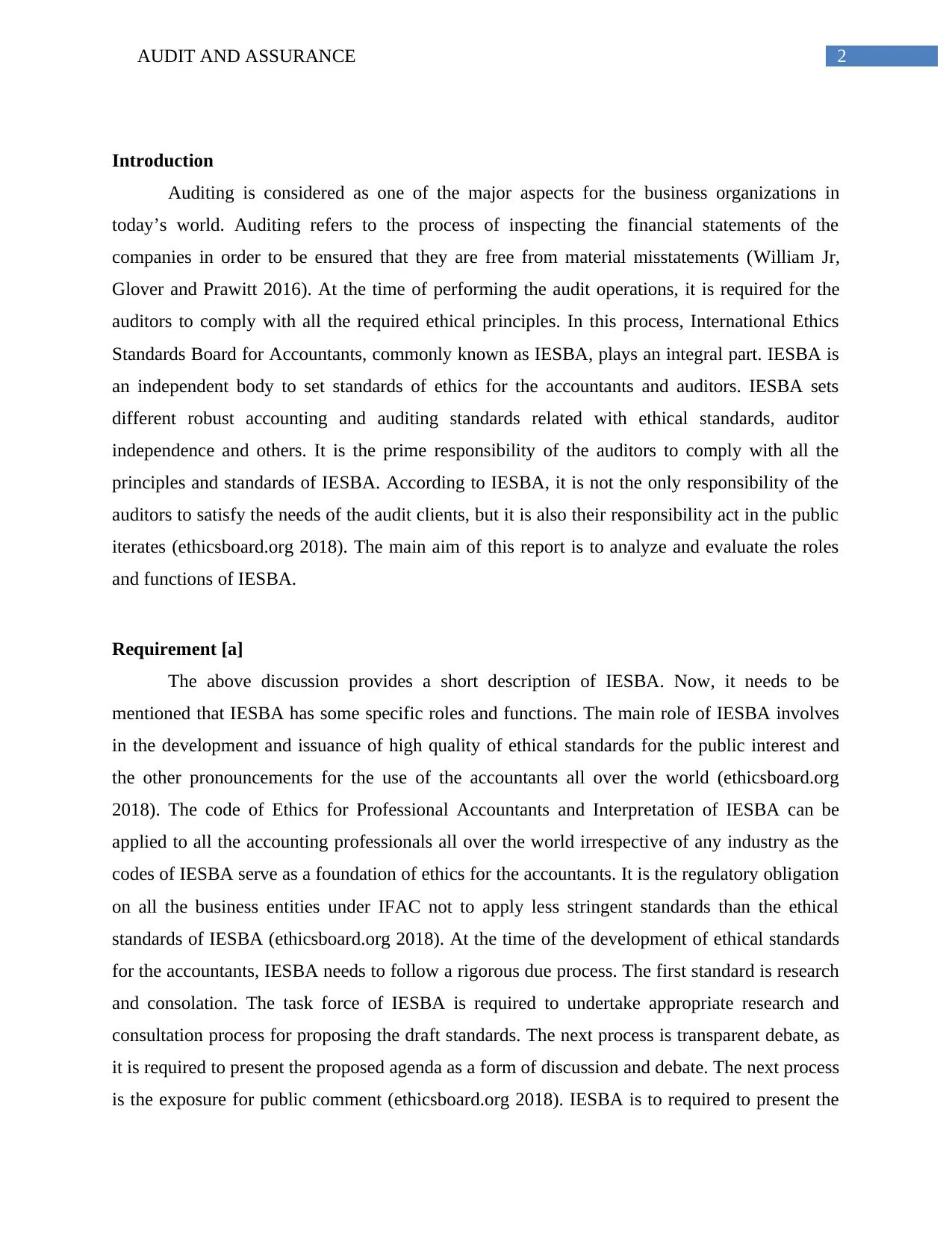
2AUDIT AND ASSURANCE
Introduction
Auditing is considered as one of the major aspects for the business organizations in
today’s world. Auditing refers to the process of inspecting the financial statements of the
companies in order to be ensured that they are free from material misstatements (William Jr,
Glover and Prawitt 2016). At the time of performing the audit operations, it is required for the
auditors to comply with all the required ethical principles. In this process, International Ethics
Standards Board for Accountants, commonly known as IESBA, plays an integral part. IESBA is
an independent body to set standards of ethics for the accountants and auditors. IESBA sets
different robust accounting and auditing standards related with ethical standards, auditor
independence and others. It is the prime responsibility of the auditors to comply with all the
principles and standards of IESBA. According to IESBA, it is not the only responsibility of the
auditors to satisfy the needs of the audit clients, but it is also their responsibility act in the public
iterates (ethicsboard.org 2018). The main aim of this report is to analyze and evaluate the roles
and functions of IESBA.
Requirement [a]
The above discussion provides a short description of IESBA. Now, it needs to be
mentioned that IESBA has some specific roles and functions. The main role of IESBA involves
in the development and issuance of high quality of ethical standards for the public interest and
the other pronouncements for the use of the accountants all over the world (ethicsboard.org
2018). The code of Ethics for Professional Accountants and Interpretation of IESBA can be
applied to all the accounting professionals all over the world irrespective of any industry as the
codes of IESBA serve as a foundation of ethics for the accountants. It is the regulatory obligation
on all the business entities under IFAC not to apply less stringent standards than the ethical
standards of IESBA (ethicsboard.org 2018). At the time of the development of ethical standards
for the accountants, IESBA needs to follow a rigorous due process. The first standard is research
and consolation. The task force of IESBA is required to undertake appropriate research and
consultation process for proposing the draft standards. The next process is transparent debate, as
it is required to present the proposed agenda as a form of discussion and debate. The next process
is the exposure for public comment (ethicsboard.org 2018). IESBA is to required to present the
Introduction
Auditing is considered as one of the major aspects for the business organizations in
today’s world. Auditing refers to the process of inspecting the financial statements of the
companies in order to be ensured that they are free from material misstatements (William Jr,
Glover and Prawitt 2016). At the time of performing the audit operations, it is required for the
auditors to comply with all the required ethical principles. In this process, International Ethics
Standards Board for Accountants, commonly known as IESBA, plays an integral part. IESBA is
an independent body to set standards of ethics for the accountants and auditors. IESBA sets
different robust accounting and auditing standards related with ethical standards, auditor
independence and others. It is the prime responsibility of the auditors to comply with all the
principles and standards of IESBA. According to IESBA, it is not the only responsibility of the
auditors to satisfy the needs of the audit clients, but it is also their responsibility act in the public
iterates (ethicsboard.org 2018). The main aim of this report is to analyze and evaluate the roles
and functions of IESBA.
Requirement [a]
The above discussion provides a short description of IESBA. Now, it needs to be
mentioned that IESBA has some specific roles and functions. The main role of IESBA involves
in the development and issuance of high quality of ethical standards for the public interest and
the other pronouncements for the use of the accountants all over the world (ethicsboard.org
2018). The code of Ethics for Professional Accountants and Interpretation of IESBA can be
applied to all the accounting professionals all over the world irrespective of any industry as the
codes of IESBA serve as a foundation of ethics for the accountants. It is the regulatory obligation
on all the business entities under IFAC not to apply less stringent standards than the ethical
standards of IESBA (ethicsboard.org 2018). At the time of the development of ethical standards
for the accountants, IESBA needs to follow a rigorous due process. The first standard is research
and consolation. The task force of IESBA is required to undertake appropriate research and
consultation process for proposing the draft standards. The next process is transparent debate, as
it is required to present the proposed agenda as a form of discussion and debate. The next process
is the exposure for public comment (ethicsboard.org 2018). IESBA is to required to present the
⊘ This is a preview!⊘
Do you want full access?
Subscribe today to unlock all pages.

Trusted by 1+ million students worldwide
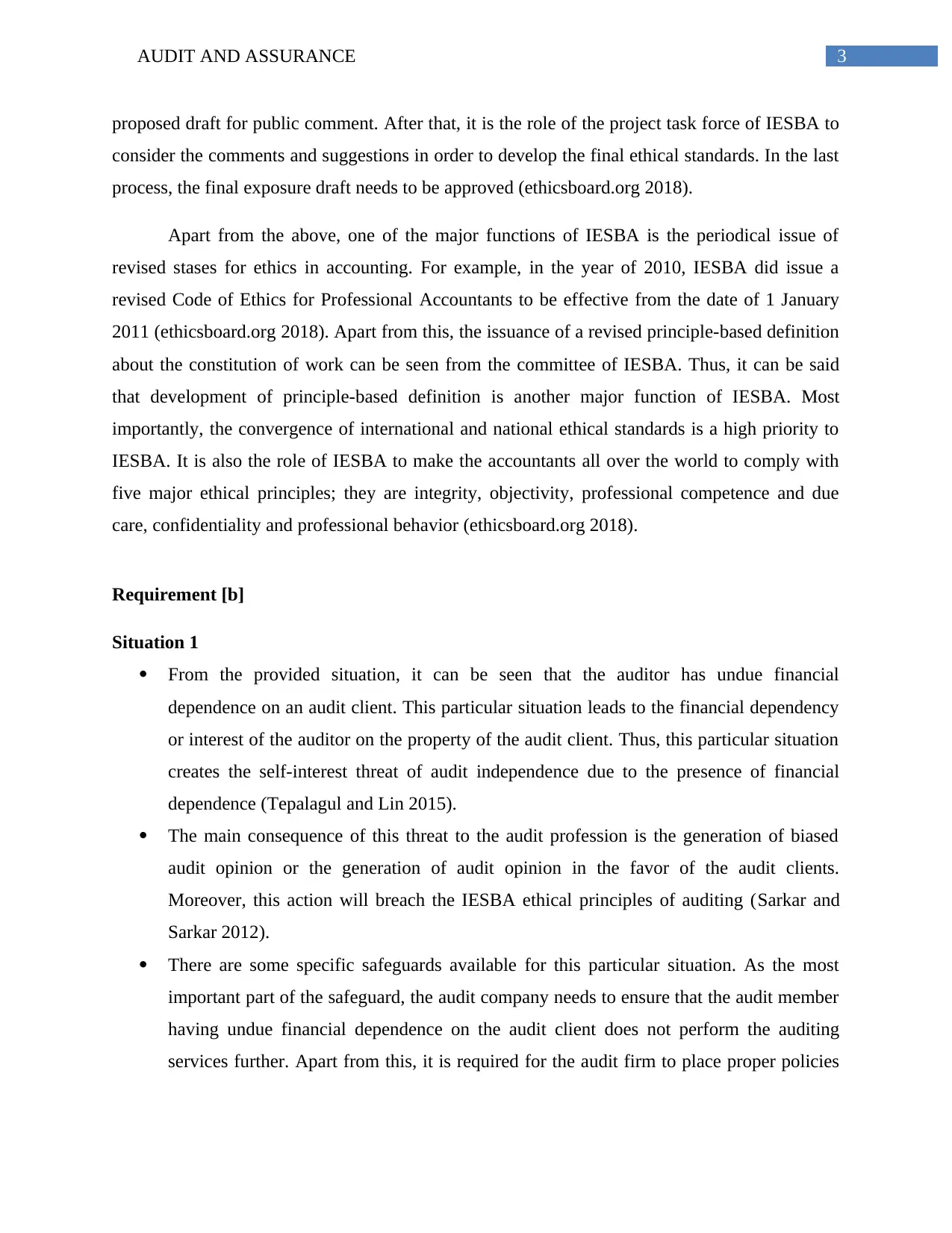
3AUDIT AND ASSURANCE
proposed draft for public comment. After that, it is the role of the project task force of IESBA to
consider the comments and suggestions in order to develop the final ethical standards. In the last
process, the final exposure draft needs to be approved (ethicsboard.org 2018).
Apart from the above, one of the major functions of IESBA is the periodical issue of
revised stases for ethics in accounting. For example, in the year of 2010, IESBA did issue a
revised Code of Ethics for Professional Accountants to be effective from the date of 1 January
2011 (ethicsboard.org 2018). Apart from this, the issuance of a revised principle-based definition
about the constitution of work can be seen from the committee of IESBA. Thus, it can be said
that development of principle-based definition is another major function of IESBA. Most
importantly, the convergence of international and national ethical standards is a high priority to
IESBA. It is also the role of IESBA to make the accountants all over the world to comply with
five major ethical principles; they are integrity, objectivity, professional competence and due
care, confidentiality and professional behavior (ethicsboard.org 2018).
Requirement [b]
Situation 1
From the provided situation, it can be seen that the auditor has undue financial
dependence on an audit client. This particular situation leads to the financial dependency
or interest of the auditor on the property of the audit client. Thus, this particular situation
creates the self-interest threat of audit independence due to the presence of financial
dependence (Tepalagul and Lin 2015).
The main consequence of this threat to the audit profession is the generation of biased
audit opinion or the generation of audit opinion in the favor of the audit clients.
Moreover, this action will breach the IESBA ethical principles of auditing (Sarkar and
Sarkar 2012).
There are some specific safeguards available for this particular situation. As the most
important part of the safeguard, the audit company needs to ensure that the audit member
having undue financial dependence on the audit client does not perform the auditing
services further. Apart from this, it is required for the audit firm to place proper policies
proposed draft for public comment. After that, it is the role of the project task force of IESBA to
consider the comments and suggestions in order to develop the final ethical standards. In the last
process, the final exposure draft needs to be approved (ethicsboard.org 2018).
Apart from the above, one of the major functions of IESBA is the periodical issue of
revised stases for ethics in accounting. For example, in the year of 2010, IESBA did issue a
revised Code of Ethics for Professional Accountants to be effective from the date of 1 January
2011 (ethicsboard.org 2018). Apart from this, the issuance of a revised principle-based definition
about the constitution of work can be seen from the committee of IESBA. Thus, it can be said
that development of principle-based definition is another major function of IESBA. Most
importantly, the convergence of international and national ethical standards is a high priority to
IESBA. It is also the role of IESBA to make the accountants all over the world to comply with
five major ethical principles; they are integrity, objectivity, professional competence and due
care, confidentiality and professional behavior (ethicsboard.org 2018).
Requirement [b]
Situation 1
From the provided situation, it can be seen that the auditor has undue financial
dependence on an audit client. This particular situation leads to the financial dependency
or interest of the auditor on the property of the audit client. Thus, this particular situation
creates the self-interest threat of audit independence due to the presence of financial
dependence (Tepalagul and Lin 2015).
The main consequence of this threat to the audit profession is the generation of biased
audit opinion or the generation of audit opinion in the favor of the audit clients.
Moreover, this action will breach the IESBA ethical principles of auditing (Sarkar and
Sarkar 2012).
There are some specific safeguards available for this particular situation. As the most
important part of the safeguard, the audit company needs to ensure that the audit member
having undue financial dependence on the audit client does not perform the auditing
services further. Apart from this, it is required for the audit firm to place proper policies
Paraphrase This Document
Need a fresh take? Get an instant paraphrase of this document with our AI Paraphraser
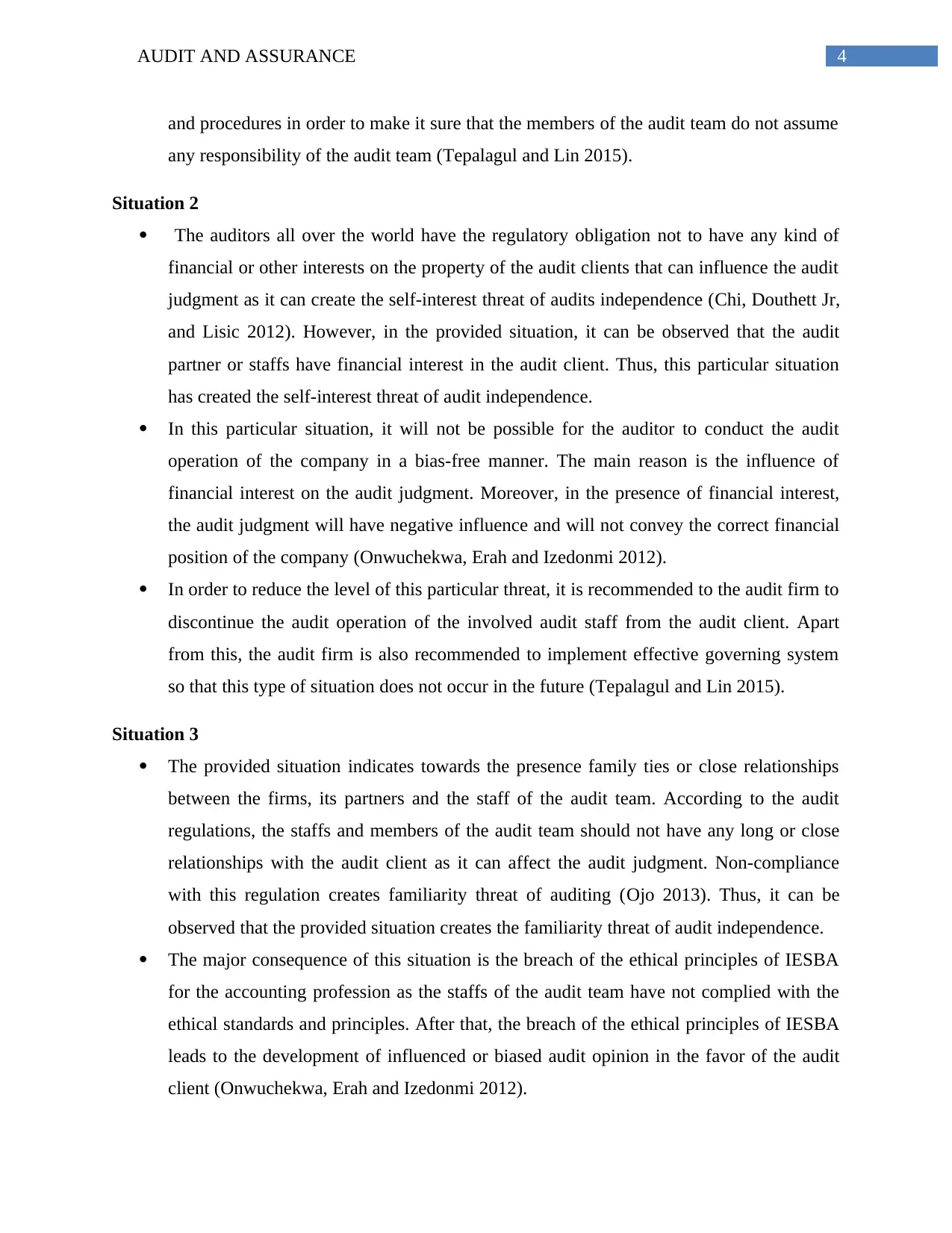
4AUDIT AND ASSURANCE
and procedures in order to make it sure that the members of the audit team do not assume
any responsibility of the audit team (Tepalagul and Lin 2015).
Situation 2
The auditors all over the world have the regulatory obligation not to have any kind of
financial or other interests on the property of the audit clients that can influence the audit
judgment as it can create the self-interest threat of audits independence (Chi, Douthett Jr,
and Lisic 2012). However, in the provided situation, it can be observed that the audit
partner or staffs have financial interest in the audit client. Thus, this particular situation
has created the self-interest threat of audit independence.
In this particular situation, it will not be possible for the auditor to conduct the audit
operation of the company in a bias-free manner. The main reason is the influence of
financial interest on the audit judgment. Moreover, in the presence of financial interest,
the audit judgment will have negative influence and will not convey the correct financial
position of the company (Onwuchekwa, Erah and Izedonmi 2012).
In order to reduce the level of this particular threat, it is recommended to the audit firm to
discontinue the audit operation of the involved audit staff from the audit client. Apart
from this, the audit firm is also recommended to implement effective governing system
so that this type of situation does not occur in the future (Tepalagul and Lin 2015).
Situation 3
The provided situation indicates towards the presence family ties or close relationships
between the firms, its partners and the staff of the audit team. According to the audit
regulations, the staffs and members of the audit team should not have any long or close
relationships with the audit client as it can affect the audit judgment. Non-compliance
with this regulation creates familiarity threat of auditing (Ojo 2013). Thus, it can be
observed that the provided situation creates the familiarity threat of audit independence.
The major consequence of this situation is the breach of the ethical principles of IESBA
for the accounting profession as the staffs of the audit team have not complied with the
ethical standards and principles. After that, the breach of the ethical principles of IESBA
leads to the development of influenced or biased audit opinion in the favor of the audit
client (Onwuchekwa, Erah and Izedonmi 2012).
and procedures in order to make it sure that the members of the audit team do not assume
any responsibility of the audit team (Tepalagul and Lin 2015).
Situation 2
The auditors all over the world have the regulatory obligation not to have any kind of
financial or other interests on the property of the audit clients that can influence the audit
judgment as it can create the self-interest threat of audits independence (Chi, Douthett Jr,
and Lisic 2012). However, in the provided situation, it can be observed that the audit
partner or staffs have financial interest in the audit client. Thus, this particular situation
has created the self-interest threat of audit independence.
In this particular situation, it will not be possible for the auditor to conduct the audit
operation of the company in a bias-free manner. The main reason is the influence of
financial interest on the audit judgment. Moreover, in the presence of financial interest,
the audit judgment will have negative influence and will not convey the correct financial
position of the company (Onwuchekwa, Erah and Izedonmi 2012).
In order to reduce the level of this particular threat, it is recommended to the audit firm to
discontinue the audit operation of the involved audit staff from the audit client. Apart
from this, the audit firm is also recommended to implement effective governing system
so that this type of situation does not occur in the future (Tepalagul and Lin 2015).
Situation 3
The provided situation indicates towards the presence family ties or close relationships
between the firms, its partners and the staff of the audit team. According to the audit
regulations, the staffs and members of the audit team should not have any long or close
relationships with the audit client as it can affect the audit judgment. Non-compliance
with this regulation creates familiarity threat of auditing (Ojo 2013). Thus, it can be
observed that the provided situation creates the familiarity threat of audit independence.
The major consequence of this situation is the breach of the ethical principles of IESBA
for the accounting profession as the staffs of the audit team have not complied with the
ethical standards and principles. After that, the breach of the ethical principles of IESBA
leads to the development of influenced or biased audit opinion in the favor of the audit
client (Onwuchekwa, Erah and Izedonmi 2012).
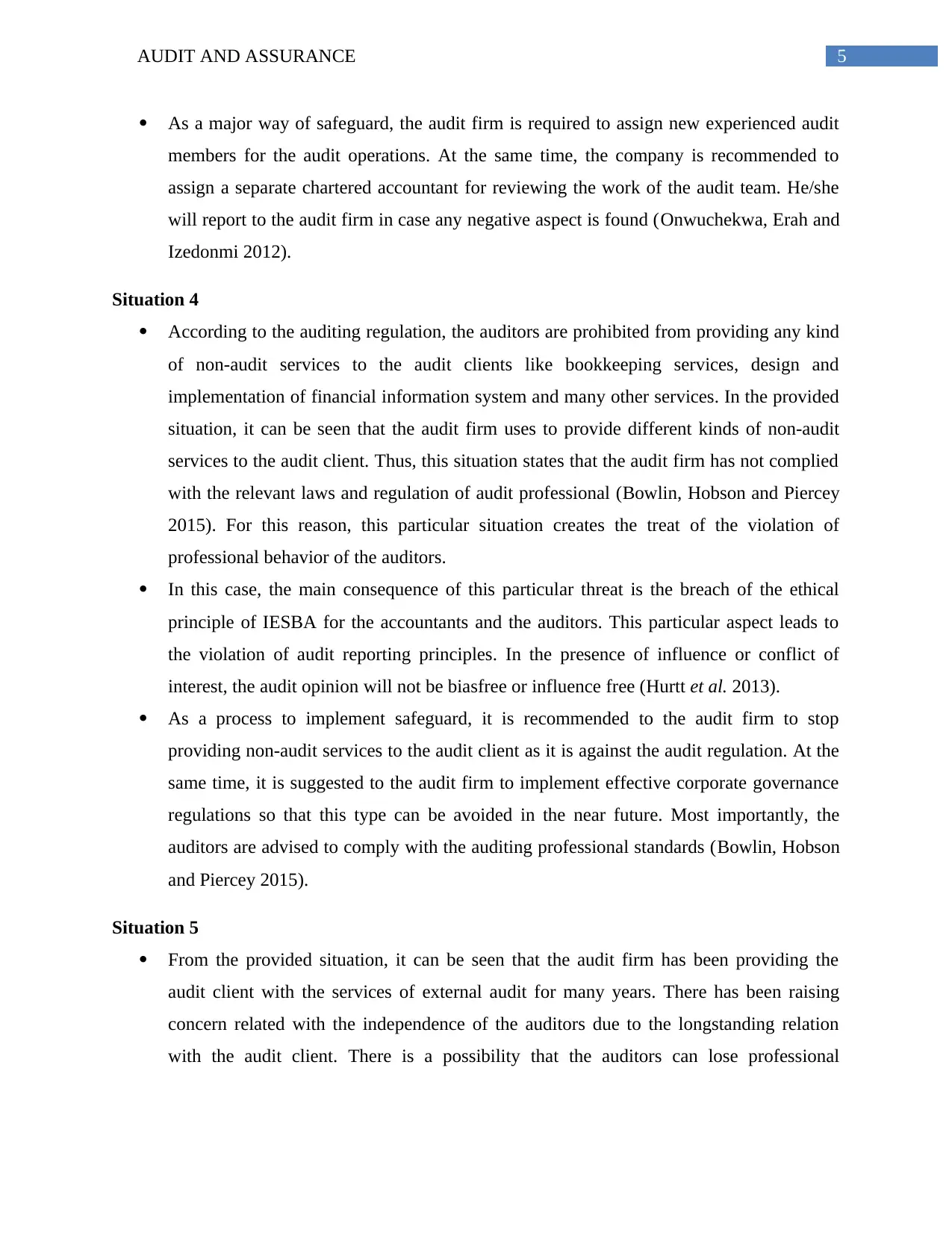
5AUDIT AND ASSURANCE
As a major way of safeguard, the audit firm is required to assign new experienced audit
members for the audit operations. At the same time, the company is recommended to
assign a separate chartered accountant for reviewing the work of the audit team. He/she
will report to the audit firm in case any negative aspect is found (Onwuchekwa, Erah and
Izedonmi 2012).
Situation 4
According to the auditing regulation, the auditors are prohibited from providing any kind
of non-audit services to the audit clients like bookkeeping services, design and
implementation of financial information system and many other services. In the provided
situation, it can be seen that the audit firm uses to provide different kinds of non-audit
services to the audit client. Thus, this situation states that the audit firm has not complied
with the relevant laws and regulation of audit professional (Bowlin, Hobson and Piercey
2015). For this reason, this particular situation creates the treat of the violation of
professional behavior of the auditors.
In this case, the main consequence of this particular threat is the breach of the ethical
principle of IESBA for the accountants and the auditors. This particular aspect leads to
the violation of audit reporting principles. In the presence of influence or conflict of
interest, the audit opinion will not be biasfree or influence free (Hurtt et al. 2013).
As a process to implement safeguard, it is recommended to the audit firm to stop
providing non-audit services to the audit client as it is against the audit regulation. At the
same time, it is suggested to the audit firm to implement effective corporate governance
regulations so that this type can be avoided in the near future. Most importantly, the
auditors are advised to comply with the auditing professional standards (Bowlin, Hobson
and Piercey 2015).
Situation 5
From the provided situation, it can be seen that the audit firm has been providing the
audit client with the services of external audit for many years. There has been raising
concern related with the independence of the auditors due to the longstanding relation
with the audit client. There is a possibility that the auditors can lose professional
As a major way of safeguard, the audit firm is required to assign new experienced audit
members for the audit operations. At the same time, the company is recommended to
assign a separate chartered accountant for reviewing the work of the audit team. He/she
will report to the audit firm in case any negative aspect is found (Onwuchekwa, Erah and
Izedonmi 2012).
Situation 4
According to the auditing regulation, the auditors are prohibited from providing any kind
of non-audit services to the audit clients like bookkeeping services, design and
implementation of financial information system and many other services. In the provided
situation, it can be seen that the audit firm uses to provide different kinds of non-audit
services to the audit client. Thus, this situation states that the audit firm has not complied
with the relevant laws and regulation of audit professional (Bowlin, Hobson and Piercey
2015). For this reason, this particular situation creates the treat of the violation of
professional behavior of the auditors.
In this case, the main consequence of this particular threat is the breach of the ethical
principle of IESBA for the accountants and the auditors. This particular aspect leads to
the violation of audit reporting principles. In the presence of influence or conflict of
interest, the audit opinion will not be biasfree or influence free (Hurtt et al. 2013).
As a process to implement safeguard, it is recommended to the audit firm to stop
providing non-audit services to the audit client as it is against the audit regulation. At the
same time, it is suggested to the audit firm to implement effective corporate governance
regulations so that this type can be avoided in the near future. Most importantly, the
auditors are advised to comply with the auditing professional standards (Bowlin, Hobson
and Piercey 2015).
Situation 5
From the provided situation, it can be seen that the audit firm has been providing the
audit client with the services of external audit for many years. There has been raising
concern related with the independence of the auditors due to the longstanding relation
with the audit client. There is a possibility that the auditors can lose professional
⊘ This is a preview!⊘
Do you want full access?
Subscribe today to unlock all pages.

Trusted by 1+ million students worldwide
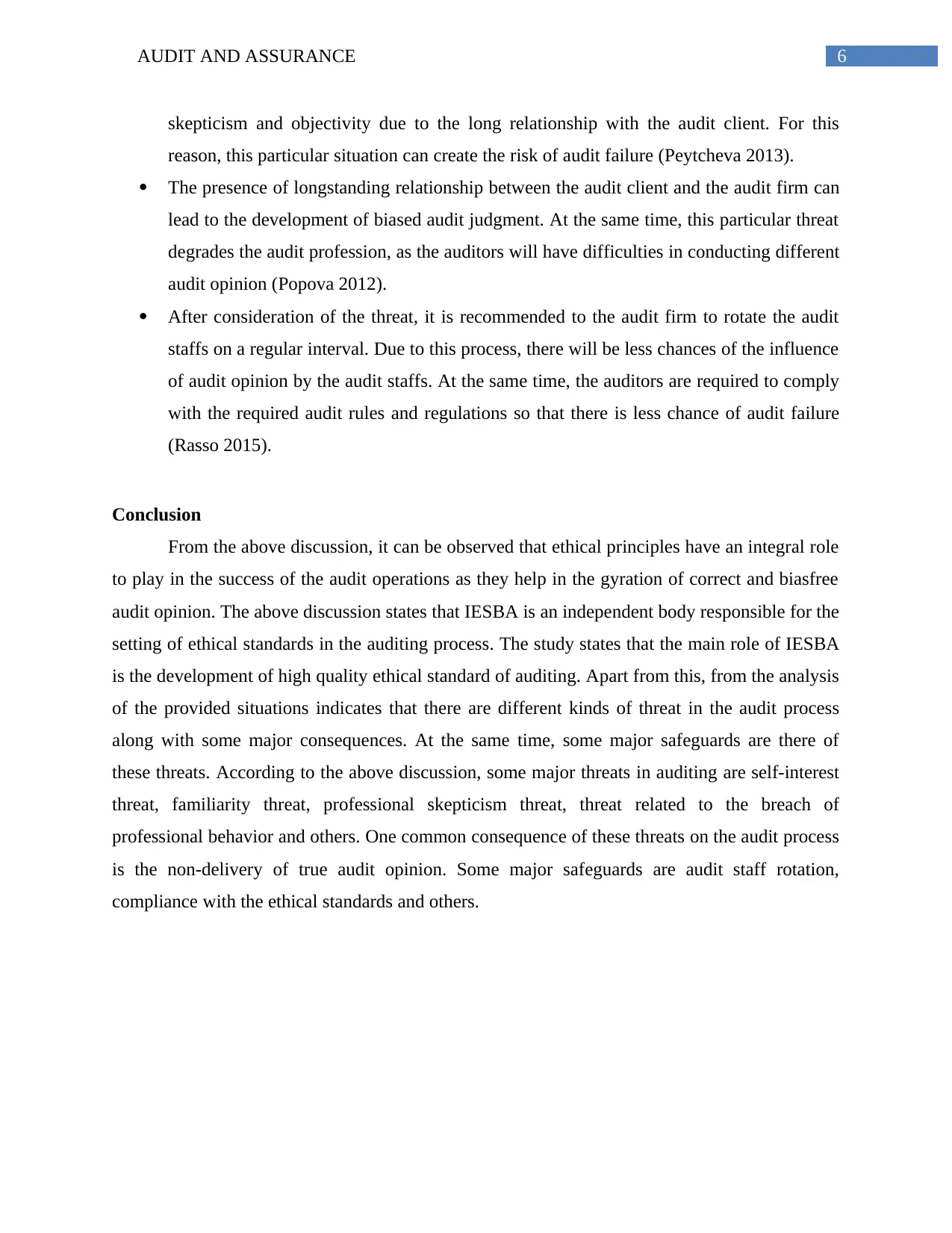
6AUDIT AND ASSURANCE
skepticism and objectivity due to the long relationship with the audit client. For this
reason, this particular situation can create the risk of audit failure (Peytcheva 2013).
The presence of longstanding relationship between the audit client and the audit firm can
lead to the development of biased audit judgment. At the same time, this particular threat
degrades the audit profession, as the auditors will have difficulties in conducting different
audit opinion (Popova 2012).
After consideration of the threat, it is recommended to the audit firm to rotate the audit
staffs on a regular interval. Due to this process, there will be less chances of the influence
of audit opinion by the audit staffs. At the same time, the auditors are required to comply
with the required audit rules and regulations so that there is less chance of audit failure
(Rasso 2015).
Conclusion
From the above discussion, it can be observed that ethical principles have an integral role
to play in the success of the audit operations as they help in the gyration of correct and biasfree
audit opinion. The above discussion states that IESBA is an independent body responsible for the
setting of ethical standards in the auditing process. The study states that the main role of IESBA
is the development of high quality ethical standard of auditing. Apart from this, from the analysis
of the provided situations indicates that there are different kinds of threat in the audit process
along with some major consequences. At the same time, some major safeguards are there of
these threats. According to the above discussion, some major threats in auditing are self-interest
threat, familiarity threat, professional skepticism threat, threat related to the breach of
professional behavior and others. One common consequence of these threats on the audit process
is the non-delivery of true audit opinion. Some major safeguards are audit staff rotation,
compliance with the ethical standards and others.
skepticism and objectivity due to the long relationship with the audit client. For this
reason, this particular situation can create the risk of audit failure (Peytcheva 2013).
The presence of longstanding relationship between the audit client and the audit firm can
lead to the development of biased audit judgment. At the same time, this particular threat
degrades the audit profession, as the auditors will have difficulties in conducting different
audit opinion (Popova 2012).
After consideration of the threat, it is recommended to the audit firm to rotate the audit
staffs on a regular interval. Due to this process, there will be less chances of the influence
of audit opinion by the audit staffs. At the same time, the auditors are required to comply
with the required audit rules and regulations so that there is less chance of audit failure
(Rasso 2015).
Conclusion
From the above discussion, it can be observed that ethical principles have an integral role
to play in the success of the audit operations as they help in the gyration of correct and biasfree
audit opinion. The above discussion states that IESBA is an independent body responsible for the
setting of ethical standards in the auditing process. The study states that the main role of IESBA
is the development of high quality ethical standard of auditing. Apart from this, from the analysis
of the provided situations indicates that there are different kinds of threat in the audit process
along with some major consequences. At the same time, some major safeguards are there of
these threats. According to the above discussion, some major threats in auditing are self-interest
threat, familiarity threat, professional skepticism threat, threat related to the breach of
professional behavior and others. One common consequence of these threats on the audit process
is the non-delivery of true audit opinion. Some major safeguards are audit staff rotation,
compliance with the ethical standards and others.
Paraphrase This Document
Need a fresh take? Get an instant paraphrase of this document with our AI Paraphraser
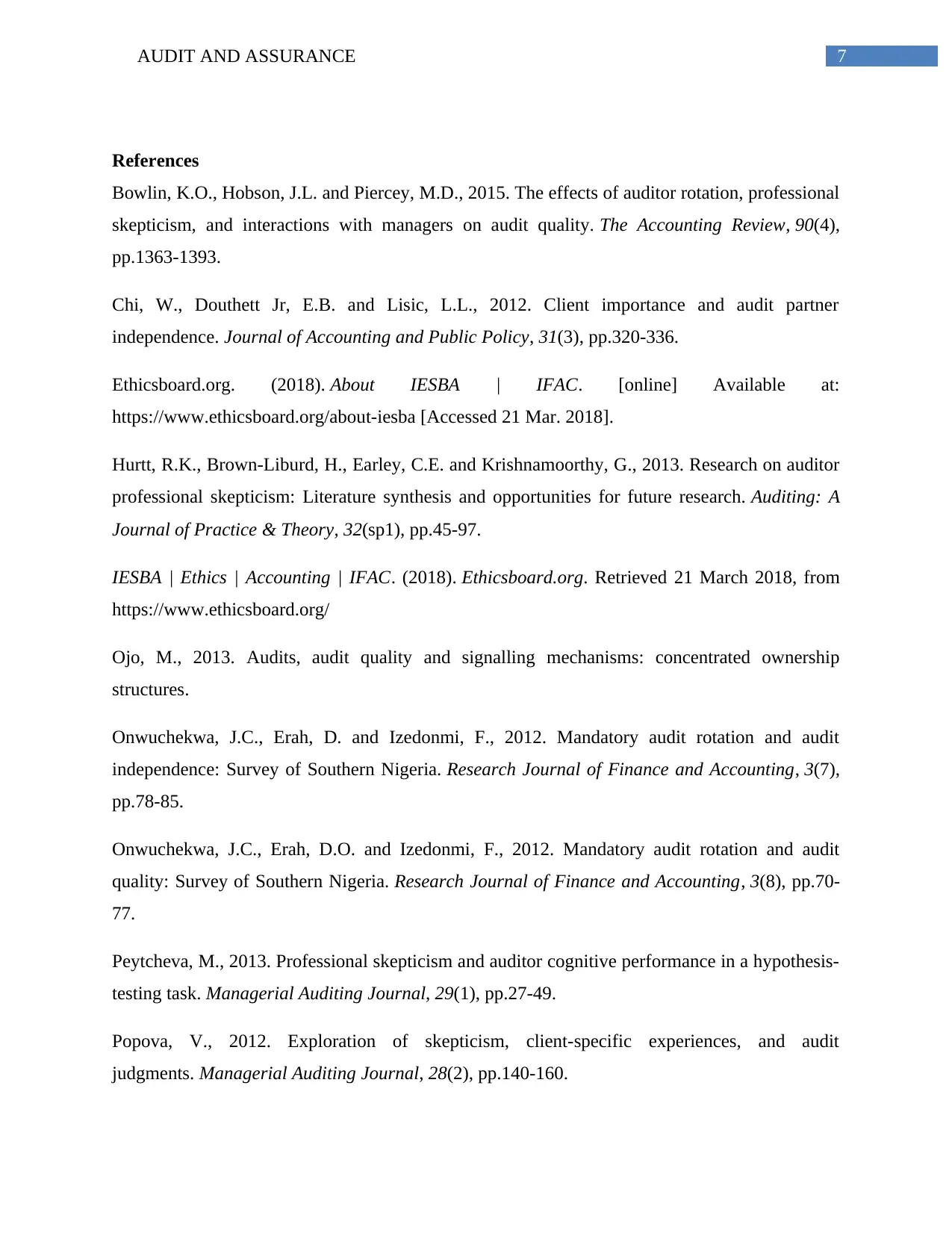
7AUDIT AND ASSURANCE
References
Bowlin, K.O., Hobson, J.L. and Piercey, M.D., 2015. The effects of auditor rotation, professional
skepticism, and interactions with managers on audit quality. The Accounting Review, 90(4),
pp.1363-1393.
Chi, W., Douthett Jr, E.B. and Lisic, L.L., 2012. Client importance and audit partner
independence. Journal of Accounting and Public Policy, 31(3), pp.320-336.
Ethicsboard.org. (2018). About IESBA | IFAC. [online] Available at:
https://www.ethicsboard.org/about-iesba [Accessed 21 Mar. 2018].
Hurtt, R.K., Brown-Liburd, H., Earley, C.E. and Krishnamoorthy, G., 2013. Research on auditor
professional skepticism: Literature synthesis and opportunities for future research. Auditing: A
Journal of Practice & Theory, 32(sp1), pp.45-97.
IESBA | Ethics | Accounting | IFAC. (2018). Ethicsboard.org. Retrieved 21 March 2018, from
https://www.ethicsboard.org/
Ojo, M., 2013. Audits, audit quality and signalling mechanisms: concentrated ownership
structures.
Onwuchekwa, J.C., Erah, D. and Izedonmi, F., 2012. Mandatory audit rotation and audit
independence: Survey of Southern Nigeria. Research Journal of Finance and Accounting, 3(7),
pp.78-85.
Onwuchekwa, J.C., Erah, D.O. and Izedonmi, F., 2012. Mandatory audit rotation and audit
quality: Survey of Southern Nigeria. Research Journal of Finance and Accounting, 3(8), pp.70-
77.
Peytcheva, M., 2013. Professional skepticism and auditor cognitive performance in a hypothesis-
testing task. Managerial Auditing Journal, 29(1), pp.27-49.
Popova, V., 2012. Exploration of skepticism, client-specific experiences, and audit
judgments. Managerial Auditing Journal, 28(2), pp.140-160.
References
Bowlin, K.O., Hobson, J.L. and Piercey, M.D., 2015. The effects of auditor rotation, professional
skepticism, and interactions with managers on audit quality. The Accounting Review, 90(4),
pp.1363-1393.
Chi, W., Douthett Jr, E.B. and Lisic, L.L., 2012. Client importance and audit partner
independence. Journal of Accounting and Public Policy, 31(3), pp.320-336.
Ethicsboard.org. (2018). About IESBA | IFAC. [online] Available at:
https://www.ethicsboard.org/about-iesba [Accessed 21 Mar. 2018].
Hurtt, R.K., Brown-Liburd, H., Earley, C.E. and Krishnamoorthy, G., 2013. Research on auditor
professional skepticism: Literature synthesis and opportunities for future research. Auditing: A
Journal of Practice & Theory, 32(sp1), pp.45-97.
IESBA | Ethics | Accounting | IFAC. (2018). Ethicsboard.org. Retrieved 21 March 2018, from
https://www.ethicsboard.org/
Ojo, M., 2013. Audits, audit quality and signalling mechanisms: concentrated ownership
structures.
Onwuchekwa, J.C., Erah, D. and Izedonmi, F., 2012. Mandatory audit rotation and audit
independence: Survey of Southern Nigeria. Research Journal of Finance and Accounting, 3(7),
pp.78-85.
Onwuchekwa, J.C., Erah, D.O. and Izedonmi, F., 2012. Mandatory audit rotation and audit
quality: Survey of Southern Nigeria. Research Journal of Finance and Accounting, 3(8), pp.70-
77.
Peytcheva, M., 2013. Professional skepticism and auditor cognitive performance in a hypothesis-
testing task. Managerial Auditing Journal, 29(1), pp.27-49.
Popova, V., 2012. Exploration of skepticism, client-specific experiences, and audit
judgments. Managerial Auditing Journal, 28(2), pp.140-160.
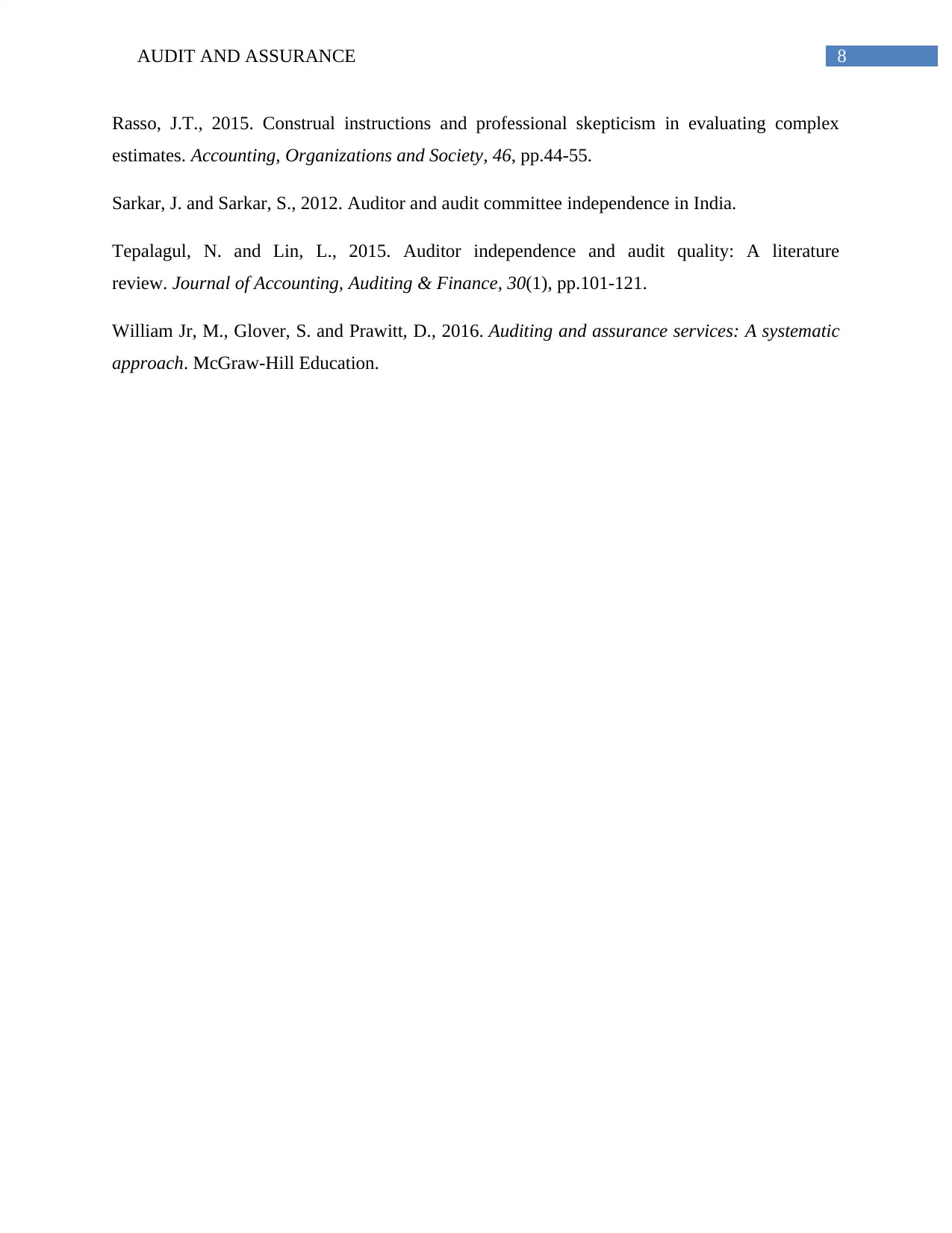
8AUDIT AND ASSURANCE
Rasso, J.T., 2015. Construal instructions and professional skepticism in evaluating complex
estimates. Accounting, Organizations and Society, 46, pp.44-55.
Sarkar, J. and Sarkar, S., 2012. Auditor and audit committee independence in India.
Tepalagul, N. and Lin, L., 2015. Auditor independence and audit quality: A literature
review. Journal of Accounting, Auditing & Finance, 30(1), pp.101-121.
William Jr, M., Glover, S. and Prawitt, D., 2016. Auditing and assurance services: A systematic
approach. McGraw-Hill Education.
Rasso, J.T., 2015. Construal instructions and professional skepticism in evaluating complex
estimates. Accounting, Organizations and Society, 46, pp.44-55.
Sarkar, J. and Sarkar, S., 2012. Auditor and audit committee independence in India.
Tepalagul, N. and Lin, L., 2015. Auditor independence and audit quality: A literature
review. Journal of Accounting, Auditing & Finance, 30(1), pp.101-121.
William Jr, M., Glover, S. and Prawitt, D., 2016. Auditing and assurance services: A systematic
approach. McGraw-Hill Education.
⊘ This is a preview!⊘
Do you want full access?
Subscribe today to unlock all pages.

Trusted by 1+ million students worldwide
1 out of 9
Related Documents
Your All-in-One AI-Powered Toolkit for Academic Success.
+13062052269
info@desklib.com
Available 24*7 on WhatsApp / Email
![[object Object]](/_next/static/media/star-bottom.7253800d.svg)
Unlock your academic potential
Copyright © 2020–2025 A2Z Services. All Rights Reserved. Developed and managed by ZUCOL.





